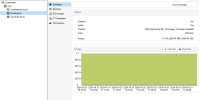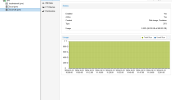Just want to add some usefull informations on the raid1 informations.
1. Yes, it is recommended to install Proxmox with ZFS as raid.
2. Yes, you better use mechanic disks (hdd) and no ssd! Or buy yourself special industrie ssd. (None Multi-Layer!)
3. If you use it for home improvement you can turn of a lot of ZFS logging which will be a bit better for a "standard ssd". Myself using 2x 120gb soho ssd (12$ each), BUT ...
4. It is NOT recommended to use any md raid, BUT you can. First install Debian 12.2 or higher. Create a normal raid1 with mdadm in the shell or right away in the GUI installer.
5. (u)EFI and a new BIOS can kill your plans. Old mainboards support a "Legacy mode". Then it is the old easy way.
New BIOS are now the first days without this option. You aew forced to EFI (or more harder boot-security).
That leads to an EPS partition, a swap partition and a root partition (at least).
6. There is no way to directly raid1 with EPS, BUT ... After installing with 2x SSD you can create md0 for swap and md1 for root and just ignore the EPS partition. That leads to a raid1 without any EPS failover.
After that just ADD in the active EPS partition in the boot order the 2nd inactive EPS partition. Copy the active boot partition to the inactive one.
-> If sda fails then sdb has an active EPS partition. While 1st is down 2nd will be used.
7. Replacing on ZFS and with mdadm on EXT4 is something total different.
8. LVM containering WILL not prevent you against the EFI limitations. Your EPS will not be "directed" correctly.
9. mdadm with Proxmox CAN lead to a major problem where you could destroy all your data.
ZFS will destroy your hardware very fast, if its not the right one!
10. My toughts: Put your Proxmox on cheap ssd. With raid1 and zfs or "single" and always hold a 1:1 copy. So if you change elementary setup on proxmox then copy again 1:1 to your 2nd ssd. In case of failure you just have to replace. I use a 6x SSD cage in a 5,25" slot. 2x cheap ssd for proxmox (right now hard testing it with md-raid and irs working awesome). 2x 2TB SSD for Data (raid1) and of course your fast NVMe. Put them in a raid1 and use it for the base install of your guest OS (Linux, Windows, Hackintosh)
And always keep in mind:
A raid is never a backup.
A NAS or SAN is never a backup even in HA mode.
Even a cluster spreaded on several actice-active SAN's with HA-iSCSI connection of each guest is not a backup or high security.
One controller error and ...
Wish you luck and I suggest ZFS with GUI install flr easy start plus logging off plus learn to replace a disk before installing active (needed) guests.



